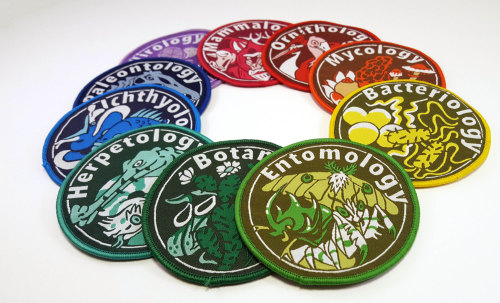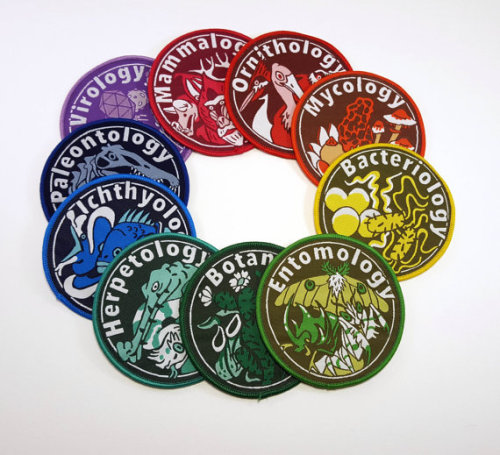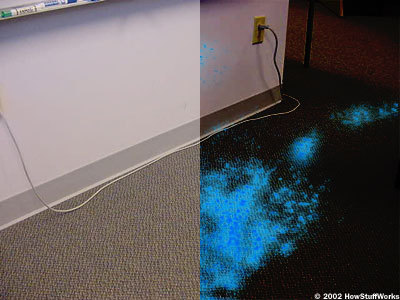BIG UPDATE!







BIG UPDATE!
I’ve finally finished my biological patches set! After many months of designing, editing, and trial and error, I’m proud to post up photos of the final products!
They are woven with bright, beautiful colors that will endure many washes and adventures to come. They’re only $8 in my store:
https://www.etsy.com/shop/Monsternium
Here are the first five patches in my biological patch set. Once all ten are made, the rainbow of studies will be complete! Each one is illustrated, digitized, and embroidered by me. Stay tuned for more! Next up is herpetology ;)
More Posts from Theperpetualscholar and Others



Physicist Create a Fluid With Negative Mass
Physicists from Washington State university have created a liquid with negative mass meaning that when you push it, instead of accelerating in that direction, it accelerates backwards.
Matter can have a negative mass much the same way that particles can be negatively charged. Newton’s second law of motion (F=ma) tells us that mass will accelerate in the direction of the force so we can deduce that matter with a negative mass would do the opposite and accelerate against the force.
To create the conditions for negative mass, Peter Engels and his team started by cooling rubidium atoms to a Bose-Einstein condensate meaning they reached very near absolute 0. The researchers used lasers to trap the atoms in an area less than 100 microns across and allow high energy particles to escape cooling them further. Then to create negative mass, the physicists applied a second set of lasers to change the way atoms spin back and forth. They then removed the first set of lasers causing the rubidium to rush out and appear to hit some sort of invisible wall; behaving as if it had a negative mass.
What’s great about this is the control we have over the negative mass without any other complications. This gives us a new tool we can use to engineer experiments in astrophysics looking at neutron stars, black holes, dark energy and a lot more.
6 TED-Ed lessons to watch on International Women’s Day
Happy International Women’s Day! Here’s a list of TED-Ed Lessons to watch as you celebrate all of the world’s women, past and present.

The genius of Marie Curie: Marie Skłodowska Curie’s revolutionary research laid the groundwork for our understanding of physics and chemistry, blazing trails in oncology, technology, medicine, and nuclear physics, to name a few. But what did she actually do? Shohini Ghose expounds on some of Marie Skłodowska Curie’s most revolutionary discoveries.

The contributions of female explorers: During the Victorian Age, women were unlikely to become great explorers, but a few intelligent, gritty and brave women made major contributions to the study of previously little-understood territory. Courtney Stephens examines three women – Marianne North, Mary Kingsley and Alexandra David-Néel – who wouldn’t take no for an answer (and shows why we should be grateful that they didn’t).

Equality, sports and Title IX: In 1972, U.S. Congress passed Title IX, a law which prohibited discrimination against women in schools, colleges, and universities — including school-sponsored sports. Before this law, female athletes were few and far between, and funding was even scarcer. Erin Buzuvis and Kristine Newhall explore the significance and complexity of Title IX.

The true story of Sacajawea: In the early 19th century, a young Agaidika teenager named Sacajawea was enlisted by explorers Meriwether Lewis and William Clark to aid her husband Toussaint Charbonneau as a guide to the Western United States. Karen Mensing debunks some of the myths that surround the familiar image of the heroic woman with a baby strapped to her back and a vast knowledge of the American wilderness.

Why should you read Virginia Woolf?: How best can we understand the internal experience of alienation? In both her essays and her fiction, Virginia Woolf shapes the slippery nature of subjective experience into words, while her characters frequently lead inner lives that are deeply at odds with their external existence. Iseult Gillespie helps make sense of these disparities to prepare you for the next time you read Virgina Woolf.

The pharaoh that wouldn’t be forgotten: Hatshepsut was a female pharaoh during the New Kingdom in Egypt. Twenty years after her death, somebody smashed her statues, took a chisel and attempted to erase the pharaoh’s name and image from history. But who did it? And why? Kate Green investigates Hatshepsut’s history for clues to this ancient puzzle.

Christopher Monroe spends his life poking at atoms with light. He arranges them into rings and chains and then massages them with lasers to explore their properties and make basic quantum computers. Last year, he decided to try something seemingly impossible: to create a time crystal.
The name sounds like a prop from Doctor Who, but it has roots in actual physics. Time crystals are hypothetical structures that pulse without requiring any energy — like a ticking clock that never needs winding. The pattern repeats in time in much the same way that the atoms of a crystal repeat in space. The idea was so challenging that when Nobel prizewinning physicist Frank Wilczek proposed the provocative concept1 in 2012, other researchers quickly proved there was no way to create time crystals.
But there was a loophole — and researchers in a separate branch of physics found a way to exploit the gap. Monroe, a physicist at the University of Maryland in College Park, and his team used chains of atoms they had constructed for other purposes to make a version of a time crystal2 (see ‘How to create a time crystal’). “I would say it sort of fell in our laps,” says Monroe.
And a group led by researchers at Harvard University in Cambridge, Massachusetts, independently fashioned time crystals out of 'dirty’ diamonds3. Both versions, which are published this week in Nature, are considered time crystals, but not how Wilczek originally imagined. “It’s less weird than the first idea, but it’s still fricking weird,” says Norman Yao, a physicist at the University of California, Berkeley, and an author on both papers.
Continue Reading.

Since I get asked a lot about where to learn more about the human brain and behaviour, I’ve made a masterpost of books, websites, videos and online courses to introduce yourself to that piece of matter that sits between your ears.
Books
The Brain Book by Rita Carter
The Pyschology Book (a good starter book) by DK
Thinking, Fast and Slow by Daniel Kahneman
Quiet: The Power of Introverts in a World That Can’t Stop Talking by Susan Cain
The Man Who Mistook His Wife for a Hat by Oliver Sacks
The Brain: The Story of You by David Eagleman
The Brain That Changes Itself: Stories of Personal Triumph from the Frontiers of Brain Science by Norman Doidge
This Is Your Brain on Music by Daniel Levitin
The Autistic Brain by Richard Panek and Temple Grandin (highly reccomended)
Sapiens: A Brief History of Humankind by Yuval Noah Harari (not really brain-related, but it is single handedly the best book I have ever read)
Websites
@tobeagenius (shameless self-promotion)
How Stuff Works
Psych2Go
BrainFacts
Neuroscience for Kids (aimed at kids, but it has some good info)
New Scientist
National Geographic
Live Science
Videos & Youtube Channels
Mind Matters series by TedEd
Crash Course Psychology
SciShow Brain
Psych2Go TV
asapSCIENCE
Brain Craft
Its Okay To Be Smart
Online Courses
The Addicted Brain
Visual Perception and The Brain
Understanding the Brain: The Neurobiology of Everyday Life
Pyschology Of Popularity
Harvard Fundamentals Of Neuroscience
Important Terms
For approaching Religious and Anthropological Studies:

Cultural Relativism:
“The ability to view the beliefs and customs of other peoples within the context of their own cultures rather than one’s own; or, describing another culture from its own point of view without imposing one’s own cultural values.” Look at what people BELIEVE, not whether or not what they believe is “true.”

Ethnocentrism (the opposite of cultural relativism):
“The tendency to judge the customs of other societies by the standards of one’s own; combines the belief in the superiority of one’s own culture with the practice of judging other cultures by the standards and values of one’s own culture.”
Harnessing ethnocentric ideas when approaching religious and cultural studies will hinder one from truly being able to learn and understand other peoples and their cultures.


Luminol is a chemical that can be used to show trace amounts of blood by creating a light producing chemical reaction when mixed with hemoglobin.
Luminol powder is mixed into a liquid containing hydrogen peroxide and other chemicals. This mixture will then be sprayed over the area that is being examined.
The reaction of the Luminol spray mixing with the iron in blood will then produce a blue glow that can be seen in a dark room.
Other substances that can accidentally have the same reaction with Luminol are: bleach, urine, faeces & horseradish.
Unfortunately Luminol can destroy other crime scene evidence so it is usually used after other options have been explored.

We’re used to radiation being invisible. With a Geiger counter, it gets turned into audible clicks. What you see above, though, is radiation’s effects made visible in a cloud chamber. In the center hangs a chunk of radioactive uranium, spitting out alpha and beta particles. The chamber also has a reservoir of alcohol and a floor cooled to -40 degrees Celsius. This generates a supersaturated cloud of alcohol vapor. When the uranium spits out a particle, it zips through the vapor, colliding with atoms and ionizing them. Those now-charged ions serve as nuclei for the vapor, which condenses into droplets that reveal the path of the particle. The characteristics of the trails are distinct to the type of decay particle that created them. In fact, both the positron and muon were first discovered in cloud chambers! (Image credit: Cloudylabs, source)

“Science, my lad, is made up of mistakes, but they are mistakes which it is useful to make, because they lead little by little to the truth.”
– Jules Verne, A Journey to the Center of the Earth










Climate Change
-
 rowan-reads liked this · 9 months ago
rowan-reads liked this · 9 months ago -
 moth-beacon liked this · 9 months ago
moth-beacon liked this · 9 months ago -
 thequailofdarkness liked this · 10 months ago
thequailofdarkness liked this · 10 months ago -
 squibiratundara reblogged this · 1 year ago
squibiratundara reblogged this · 1 year ago -
 squibiratundara liked this · 1 year ago
squibiratundara liked this · 1 year ago -
 pangolin725 liked this · 1 year ago
pangolin725 liked this · 1 year ago -
 demonwolfgoodies liked this · 1 year ago
demonwolfgoodies liked this · 1 year ago -
 spencerscookies liked this · 1 year ago
spencerscookies liked this · 1 year ago -
 lacdejellyfish reblogged this · 1 year ago
lacdejellyfish reblogged this · 1 year ago -
 ruththe-reckless reblogged this · 2 years ago
ruththe-reckless reblogged this · 2 years ago -
 eclectichellmouth reblogged this · 2 years ago
eclectichellmouth reblogged this · 2 years ago -
 falling-fading-lost liked this · 2 years ago
falling-fading-lost liked this · 2 years ago -
 kol97-sex-30das liked this · 3 years ago
kol97-sex-30das liked this · 3 years ago -
 alychampignon reblogged this · 4 years ago
alychampignon reblogged this · 4 years ago -
 alychampignon liked this · 4 years ago
alychampignon liked this · 4 years ago -
 alisonlovesmushrooms reblogged this · 4 years ago
alisonlovesmushrooms reblogged this · 4 years ago -
 monsternium reblogged this · 4 years ago
monsternium reblogged this · 4 years ago -
 arabella-31 liked this · 4 years ago
arabella-31 liked this · 4 years ago -
 failinggravity liked this · 4 years ago
failinggravity liked this · 4 years ago -
 minie-mastermind liked this · 5 years ago
minie-mastermind liked this · 5 years ago -
 cashwheel liked this · 5 years ago
cashwheel liked this · 5 years ago -
 vinnie2757 reblogged this · 5 years ago
vinnie2757 reblogged this · 5 years ago -
 the-knight-who-says-ni liked this · 5 years ago
the-knight-who-says-ni liked this · 5 years ago -
 aflamethatneverdies liked this · 5 years ago
aflamethatneverdies liked this · 5 years ago -
 ardenrosegarden reblogged this · 5 years ago
ardenrosegarden reblogged this · 5 years ago -
 maxkat899 reblogged this · 5 years ago
maxkat899 reblogged this · 5 years ago -
 maxkat899 liked this · 5 years ago
maxkat899 liked this · 5 years ago -
 terrakionn liked this · 5 years ago
terrakionn liked this · 5 years ago -
 midflybird liked this · 5 years ago
midflybird liked this · 5 years ago -
 straighthomiesexual reblogged this · 5 years ago
straighthomiesexual reblogged this · 5 years ago -
 straighthomiesexual liked this · 5 years ago
straighthomiesexual liked this · 5 years ago -
 tenderhaunted reblogged this · 5 years ago
tenderhaunted reblogged this · 5 years ago -
 onemillionfurries reblogged this · 5 years ago
onemillionfurries reblogged this · 5 years ago
